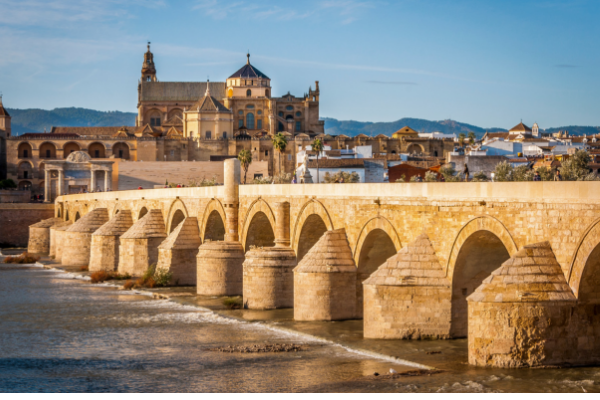Once the most cultured city in all of Europe, you have to visit Cordoba, once in your life if only to experience the spellbinding Mezquita Mosque-Cathedral of Córdoba. Considered as being one of the world’s utmost Islamic buildings, the Mezquita symbolizes how culturally sophisticated Cordoba was more than a millennium ago.
If you were to cast all of Andalucía’s great cities in a film, Cordoba would play an important cameo before being overshadowed by Granada and Seville, yet Cordoba has a unique heritage as being one of Europe’s greatest medieval city’s and was, in fact, the largest city in Europe during the 10th century.
When we refer to Cordoba as a city we are only doing so due to the fact that today it has a population of 325,000 spread over a large area. The older part of Cordoba and the places you want to see are all within walking distance down orange-scented stone-paved lanes that open out into hidden plazas.
While Cordoba is worth visiting just to see its historical treasures, the city is emerging as a new player in the world of gastronomy as well, with plenty of tapas bars and Michelin aspiring restaurants eager to show you their avant-garde menus.
Quick Facts about Cordoba
Here’s a few interesting tidbits of information about the city of Cordoba:
Where is Cordoba?
Cordoba is located on the banks of the Guadalquivir River in Andalucía, southern Spain and is Andalucía’s third largest city.
History & Architecture in Cordoba
Carthaginian’s Roman’s and Moors have all left their mark on Cordoba, with the centre of the city named as a UNESCO site of Outstanding Universal Value who’s greatest days were during the 8th century following the Moorish conquest of the Iberian Peninsula. During Islamic rule, the city had 300 mosques, palaces and public buildings all built to rival the wonders of Damascus, Bagdad and Constantinople. Following the expulsion of the Moors from Spain in the 13th century, the Great Mosque of Córdoba was turned into a cathedral by Ferdinand III of Castile, while building defensive fortifications such as the Alcázar de los Reyes Cristianos and the Torre Fortaleza de la Calahorra.
How to get to Cordoba
Despite its size, Cordoba does not have an airport that accepts commercial flights. The closest airports are Seville, Jerez, Granada and Malaga all within a three-hour drive. Cordoba’s big plus when it comes to getting there is the fact that it is on Spain’s AVE high-speed rail network only 1 hour and 40 minutes from Madrid and just 50 minutes from Malaga.
When is the best time to visit Cordoba?
Córdoba has the distinction of being the hottest city in Europe and is best avoided during July and August when temperatures average 37 °C (99 °F).
If you had to pick an optimum time to visit it would have to be during April to June with the highlight being the Festival of the Patios (May 5 to 18), when local homes are opened to the public revealing flower-filled courtyards.
Where to stay in Cordoba
If your budget can stretch into the hundreds of pounds, the place to stay is the 5-star Hospes Palacio Del Bailio located in a remodelled 16th-century palace on the remains of a Roman villa. For those with not so deep pockets, the Hotel Lola is ideally placed just a few metres from the Mezquita.
Things To Do in Cordoba
Considered to be one of the world’s greatest landmarks the Mezquita alone is worth the trip to Cordoba. Following the Reconquista, all the mosques in Spain were destroyed except for the Grand Mosque who’s beauty inspired the Catholic kings to build a cathedral inside the original structure.
*Tip: Entrance to the Mezquita is free from 8.30 to 9.30am
Headquarters of the Spanish Inquisition, a period of religious intolerance and repression, the Alcázar is both a fortress and palace with interesting Roman mosaics and Moorish courtyards and fountains.
Walk along the Calleja de las Flores and discover a maze of streets selling artisan crafts before visiting the House of Sepharad where you can learn about the persecution of the Jews during the Spanish Inquisition before stumbling upon one of only three synagogues in Spain that date back to medieval times.





